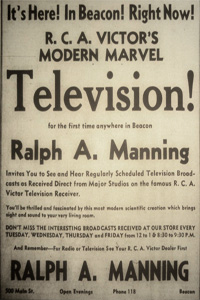First Television Set in Beacon!
Ralph Manning was a businessman ahead of his times. Soon after he had opened his auto supplies store at 500 Main Street (complete with "Tydol" gasoline pumps on the sidewalk) in the mid-1920s, he capitalized on the latest rage--radio broadcasting--by adding Atwater-Kent cabinet radios for sale next to his line of auto batteries and tires. In 1939, again thinking more of the living room than the garage, Manning stocked for sale the first television set in Beacon.
The date was August 31, 1939, and the television was a top-of-the-line RCA model TRK-12, with a 5" by 12" picture tube capable of receiving 5 channels. Its cost was $600, expensive by any measure when the average price of a new car then was $700. Television had broken into the airwaves on April 30, 1939, when RCA and the National Broadcasting Company broadcast live the opening ceremony of the New York World's Fair. No matter that there were probably only 100 sets at the time in the New York area to see President Franklin Roosevelt speak at the Fair--the new medium in the communications industry was here to stay. Station W2XBS in New York almost immediately began broadcasting several hours a day, five days a week, including sporting events, feature films, and live one-hour dramas. Manning placed his TRK-12 model in his store window and the crowds gathered outside to peer in.
With his television antenna staked down on the roof of 500 Main, Manning offered two hours (12:30 to 1:30 and 8:30 to 9:30 pm) of TV viewing, Tuesday through Fridays. He advertised Fordham football games and the first made for TV dramas. Yet sales were disappointing. In the fall of 1939, RCA chose Newburgh as a test city and opened a two-month sales campaign there, reducing the cost by one third on all of its models. Newburgh responded and over 100 sets were sold. Testimonials from happy customers filled Manning's advertisements: "No one can possibly realize the joy of television entertainment," wrote John Crawford of Newburgh, "until they have a television set in the home. In my opinion this is history in the making."
A one-eyed monster, television, had been let loose on American culture.




